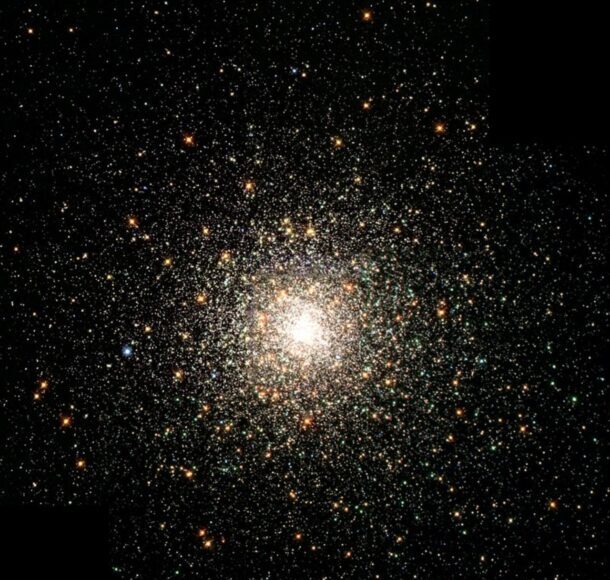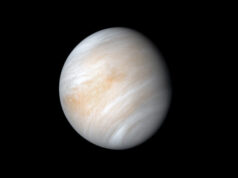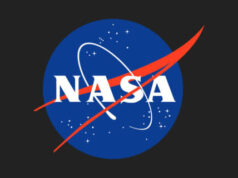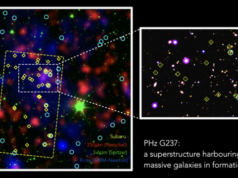Analysing images from the Hubble and Spitzer Space Telescopes, the researchers calculated the age of these galaxies as ranging from 200 to 300 million years, allowing an estimate of when their stars first formed.
Cosmic dawn, when stars formed for the first time, occurred 250 million to 350 million years after the beginning of the universe, according to a new study led by researchers at University College London (UCL) and the University of Cambridge.
The study, published in the Monthly Notices of the Royal Astronomical Society, suggests that the NASA James Webb Space Telescope (JWST), scheduled to launch in November, will be sensitive enough to observe the birth of galaxies directly.
The UK-led research team examined six of the most distant galaxies currently known, whose light has taken most of the universe’s lifetime to reach us. They found that the distance of these galaxies away from Earth corresponded to a “look back” time of more than 13 billion years ago, when the universe was only 550 million years old.
Analyzing images from the Hubble and Spitzer Space Telescopes, the researchers calculated the age of these galaxies as ranging from 200 to 300 million years, allowing an estimate of when their stars first formed.
Find your dream job in the space industry. Check our Space Job Board »
Lead author Dr. Nicolas Laporte (University of Cambridge), who started the project while at UCL, said: “Theorists speculate that the universe was a dark place for the first few hundred million years, before the first stars and galaxies formed.
“Witnessing the moment when the universe was first bathed in starlight is a major quest in astronomy.

“Our observations indicate that cosmic dawn occurred between 250 and 350 million years after the beginning of the universe, and, at the time of their formation, galaxies such as the ones we studied would have been sufficiently luminous to be seen with the James Webb Space Telescope.”
The researchers analyzed starlight from the galaxies as recorded by the Hubble and Spitzer Space Telescopes, examining a marker in their energy distribution indicative of the presence of atomic hydrogen in their stellar atmospheres. This provides an estimate of the age of the stars they contain.
This hydrogen signature increases in strength as the stellar population ages but diminishes when the galaxy is older than a billion years. The age-dependence arises because the more massive stars that contribute to this signal burn their nuclear fuel more rapidly and therefore die first.
Co-author Dr. Romain Meyer (UCL Physics & Astronomy and the Max Planck Institute for Astronomy in Heidelberg, Germany) said: “This age indicator is used to date stars in our own neighborhood in the Milky Way but it can also be used to date extremely remote galaxies, seen at a very early period of the universe.
“Using this indicator we can infer that, even at these early times, our galaxies are between 200 and 300 million years old.”
In analyzing the data from Hubble and Spitzer, the researchers needed to estimate the “redshift” of each galaxy which indicates their cosmological distance and hence the look-back time at which they are being observed. To achieve this, they undertook spectroscopic measurements using the full armory of powerful ground-based telescopes—the Chilean Atacama Large Millimetre Array (ALMA), the European Very Large Telescope, the twin Keck telescopes in Hawaii, and Gemini-South telescope.
Co-author Professor Richard Ellis (UCL Physics & Astronomy), who has tracked ever more distant galaxies over his career, said: “Over the last decade, astronomers have pushed back the frontiers of what we can observe to a time when the universe was only 4% of its present age. However, due to the limited transparency of Earth’s atmosphere and the capabilities of the Hubble and Spitzer Space Telescopes, we have reached our limit.
“We now eagerly await the launch of the James Webb Space Telescope, which we believe has the capability to directly witness cosmic dawn.
“The quest to see this important moment in the universe’s history has been a holy grail in astronomy for decades. Since we are made of material processed in stars, this is in some sense the search for our own origins.”
The new study involved astronomers at the University of California-Santa Cruz, the University of California, and the University of Texas.
The NASA-led James Webb Space Telescope, the successor to the Hubble observatory, is scheduled to be launched into space in November. It will be the premier observatory over the next decade, serving thousands of astronomers worldwide. It consists of an infrared observatory, an immense mirror 6.5 meters wide, and a diamond-shaped sunshield. UCL scientists at the Mullard Space Science Laboratory have built and tested key hardware components for the NIRSpec (Near-Infrared Spectrograph), one of the telescope’s four instruments.











